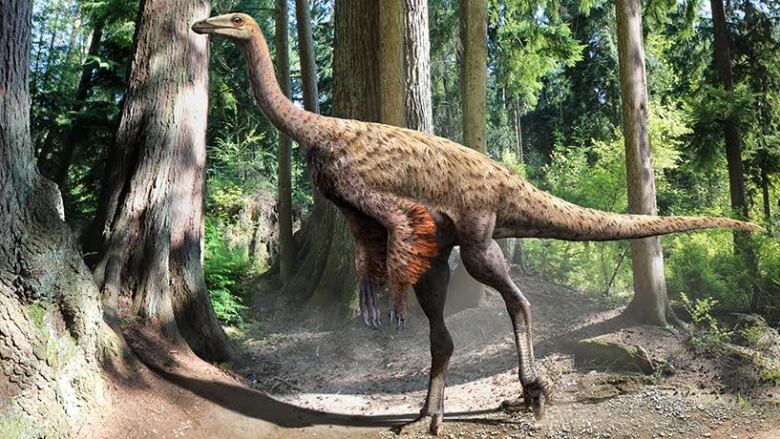Dino of the week: Ornithomimus
Big beaked and powerful legs, these bird-like dinos were speedy sprinters

He may have been a small-brained bird, but this ostrich-like beast would certainly have outrun the rest of the dinosaurs which once roamed prehistoricAlberta.
The Ornithomimusonce populated a large expanse of North America.
These featheredcreatures had powerful gangly legs which would have carried them across the plains at blazing speeds.
As part of CBC Edmonton's summer-long series Backyard Dinosaurs which will feature a different dinosaur found in Alberta each week University of Alberta paleontologist Scott Persons talked about this track star.
When first discovered, the Ornithomimus, which means "bird mimic," was among the most bird-like of all known dinosaurs.
"Ornithomimus bears a striking resemblance to a modern ostrich or emu," said Persons.
"It had a small headwith big eyes and a blunt toothless beak, a long skinny S-curved neck, and it moved about on two long legs."
Ornithomimus not only resembled an ostrich, but its skeleton suggests it behaved like an ostrich as well meaning it could hit some serious speed.
"The ostrich is the fastest modern ground bird and able to run up to 70 kilometresan hour which is as fast as a race horse,"Persons said.
"An animal's speed depends on a lot factors, including a lot of anatomical traits that don't generally fossilize, like the size of its leg muscles, the arrangement of its tendons, the capacity of it lungs,and the power of its heart.
"But I wouldn't be surprised if Ornithomimus could reach ostrich-grade speed."
Although Ornithomimus was on the same branch of the family tree that did ultimately give rise to birds, Persons saysthese ancient animals were not a directancestor of theirmodern day counterparts.
Instead, many of similarities between Ornithomimus and ostriches are a result of a common phenomenon called convergent evolution when two organisms wind up evolving similar body forms, because they are adapting to fill the same general ecological role.
"The classic example is how much whales and dolphins resemble fish because they have both evolved to live in the water,"Persons said.
"Ornithomimus looked like an ostrich because it probably lived a lot like an ostrich."













_(720p).jpg)


 OFFICIAL HD MUSIC VIDEO.jpg)
.jpg)



























































































